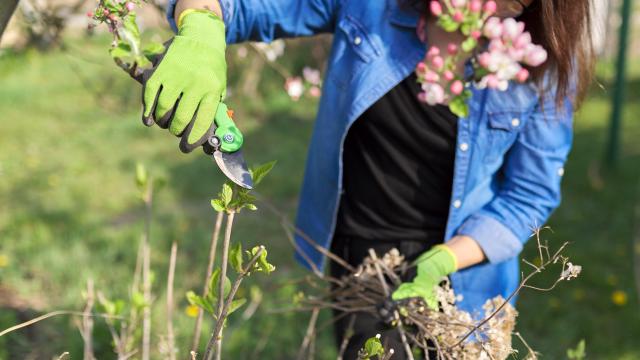Pruning is an important garden task. Besides simply keeping growth in check, proper pruning also keeps trees and shrubs healthy by ensuring that light and air can reach all the branches. Pruning at the right time can also encourage more flowers to bloom, so it’s a good skill to master if you want your yard to look its best.
What to prune in the spring
Spring is one of the best times to prune your trees, shrubs, and plants, but it’s not the right time for everything in the garden. It’s important to know which ones are which, but there’s also one exception to the rule: If you spot dead, diseased, or damaged branches, you can remove those anytime — the sooner the better.
Summer flowering bushes
Most bushes that flower in the summer do so on new growth. That means you can prune anything you like in the spring, since the new growth hasn’t started yet. Butterfly bush and rose of sharon fall into this category.
Vines
Perennial vines like trumpet vine and ivy can be pruned in the spring, since they bloom on new growth. You can trim ivy anytime, but it’s easiest to shape it in the spring before leaves appear.
Evergreens
Evergreen trees and bushes fall into two categories when it comes to pruning. Fir, spruce, and pine trees branch in a whorl pattern, and usually don’t need much pruning at all. If you do need to prune them to slow their growth, spring or early summer is a good time to trim back the new growth on each branch.
The other type is called a random-branching conifer, and these include arborvitae and juniper. Since they have buds all along their stems, you can cut them almost anywhere. In spring, prune individual branches back to where they emerge from main branches. If you’d like to shear the whole plant to maintain size, save that job for summer when the shrub has finished growing.
Fruit trees
Fruit trees flower in spring, but they’re an exception to the rule since pruning is so important for maintaining a healthy tree. If you lose a few buds in the process, so be it.
In spring, when the tree is still dormant, you’ll be able to see the structure of it well. A good fruit tree will have a central leader, branches at a strong angle so that heavy fruit won’t cause them to break, and will be short enough that you can still reach most of the fruit. Fruit trees also need to allow sunlight to reach most of the branches (because sun is important for ripening) and to allow good airflow, which helps to prevent disease.
What not to prune in spring
As you’re doing your spring pruning, it’s important not to prune certain plants. Any plants that you grow for their flowers, and that flower in the spring, shouldn’t be pruned until after they are done flowering. (That June 15 rule is useful here.)
Lilacs and forsythia, for example: if you prune them in the spring, you’ll be removing the parts of the plant that become flower buds. Wait until after they bloom, and then prune as much as you like.
How to prune
Always start by looking for dead, diseased, or damaged branches. These can be removed anytime, and there are no decisions to be made; they have to go.
Next, look for crossed branches. Pick the better or stronger branch, and remove the other one.
Water sprouts and suckers should be removed next. (Water sprouts grow from the trunk, suckers from the base of the tree.) These are thin, fast-growing, vertical sprouts that are usually trimmed because the tree uses energy to grow them, but they don’t contribute to the shape or fruit that you’re trying to achieve.
If you’re working on a tree that has large branches, use a two- or three-step cut to make sure the branch doesn’t tear off healthy bark as it separates.
For smaller branches, usually you’ll want to make a thinning cut, which removes a small branch at the point where it came from a larger branch. These are effective at removing the branch without causing further growth. The opposite would be a heading cut, which can trigger growth of side branches or buds. You would do this if you wanted to encourage the plant to grow bushier.
Finally, when you make a pruning cut, don’t apply anything to seal the wound. This is meant to help the cut to heal, but it’s more likely to encourage rotting and disease than to prevent it. The plant can heal its own wounds better than we can. But to be safe, it’s best to plan ahead so that you never need to make a large cut — you do that by pruning smaller branches more often, instead of letting a tree go for several years without any pruning.

Leave a Reply
You must be logged in to post a comment.